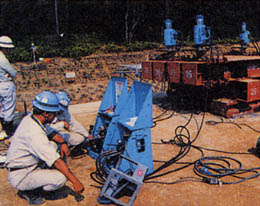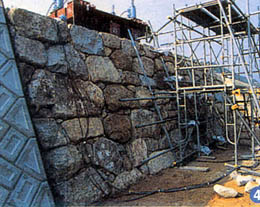Analyzing the secret technique of Anoushu stone stacking
| Visiting the old to learn the new. The analyzed data that proved the traditional technique. |  A scene from the experiment |
|---|---|
| Although the Anoushu stone stacking method has proven its robustness through its long history, to be applicable to the modern architectural standards, empirical data was needed.
Therefore, an experiment was conducted where an Anoushu retaining wall was built next to a concrete block retaining wall, and then earth pressure was applied to them to measure displacement.
The standard for maximum load was 250 ton. To create a more sever condition, a weight of a jumbo jet, which will never happen in reality, was applied. | |
| Soon after the experiment was started, the retaining wall built by the Anoushu started to make unfamiliar crackling noises. The stone wall, in sections, had as much as 13 cm displacement, but, it withstood the entire 250-ton pressure. On the other hand, the concrete block retaining wall only had 5.5 cm displacement, however, when the pressure reached around 200 ton, the 30cm thick cast concrete made a loud busting sound and it failed. Although the displacement of the stone wall was larger, this experiment affirmed that it had a superior load bearing capacity than the concrete block wall. | 
|
| The "flexible" load bearing capacity confirmed through state-of-the-art technology |  Anoushu style stone stacking structural drawing |
| A simulation called discontinuous deformation analysis, ran by the group led by professor Yuzo Onishi, from Kyoto University graduate program, made clear the structural characteristics of Anoushu style stone stacking. Anoushu style stone stacking structural drawing The simulation faithfully recreated the model of the stone wall structure under pressure. The result perfectly matched the certification test result. Then, another simulation was ran using the seismic data of Hanshin-Awaji class earthquake. The result showed that, again, there was a large displacement, but, it provided an excellent data showing that because of its displacement, the stones tightened and did not lead to its collapse and ceasing of retaining function. |